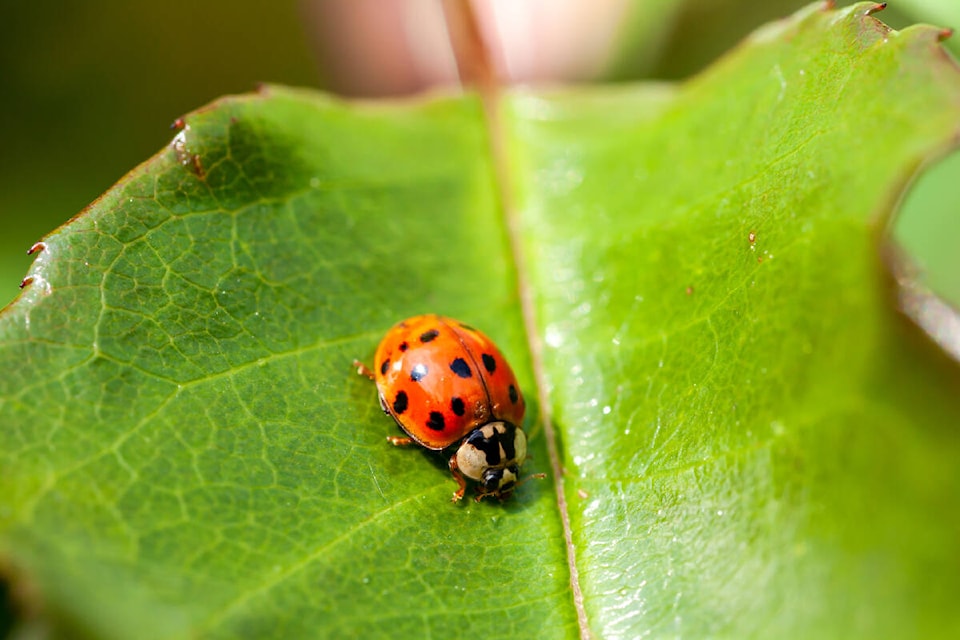By Leslie Cox
Special to the Record
The clear weather for the recent lunar eclipse certainly sent the thermometer plummeting. Had us digging out our winter sweaters, toques and insulated gloves. Even our pooch, Sadie, swapped over her raincoat for her thick Canadian sweater.
But we are not the only ones feeling the cold. Certain insects are also seeking warmer environments and one such place at the top of their preferred list is our homes. Nothing like central heating on a blustery, freezing day.
One such home invader may be ladybugs… or beetles as some prefer to call them… that gather on window sills and walls of our homes.
Did you know ladybugs can live two to three years? The adults hibernate through the winter months, typically outdoors in tree bark cracks, under rocks or wherever they find some protection.
However, the ones which find their way indoors are the Asian ladybug, Harmonia axyridis. (Also known as the multicolored Asian ladybug or Harlequin lady beetle.)
This foreign ladybug species was originally introduced into California in 1916 to help control aphids. It did not flourish well in its new surroundings and subsequent re-introductions were made in various parts of the United States and in Nova Scotia up until 1981. It took until 1988 for Asian ladybugs to be recognized as an established species in Louisiana and from there these ladybugs spread, arriving in Canada in 1994.
Now they have become a bit of a problem because if there is not enough food, they will predate on other ladybug species.
Indoors, their sheer numbers can be overwhelming and if you try to brush them off the sill, they exude a foul odour. And, unlike our lovely native ladybug species, the Asian ladybugs bite. Had one land on my hand and it promptly started to bite the fleshy area between thumb and forefinger. Darn painful, let me tell you.
In spite of these deterrents, best to put on gloves, hold your breath and sweep them into a container to be deposited back outdoors. But be sure to find those cracks where the little spotted devils are getting inside and seal them.
Another pest of concern is the Brown marmorated stink bug, Halyomorpha halys. It is also an Asian native but, unlike the Asian ladybug, this insect was most definitely not intentionally introduced into North America.
Instead, we can thank global trade routes for carrying this hitchhiker in shipping containers, wood products, vehicles and a host of other products that make their way from Asia to our continent.
The BMSB as this pest is also known, was first spotted in Vancouver and the Fraser Valley in 2015, gradually spreading northeast into the Okanagan and west to Brentwood Bay by 2017.
It was about that time this pest entered my radar and since then, I have been making periodic Google checks on its migration progress. So far, I had found no mention of any BMSB discovered north of Victoria. Slightly strange I know, given this insect’s tendency to hitch rides due to its poor flying capabilities.
So, imagine my surprise to learn from a local gardener that she had some BMSBs invade her Comox bathroom through an open window!
I went back to Google but still no mention of BMSB north of Victoria. So I contacted the insect expert, Dr. Linda Gilkeson and learned BMSB are indeed here. In fact, they are as far north as Campbell River. (Not in our garden. Yet.)
Go to https://bit.ly/2MrfniM for some excellent information and photos of the BMSB.
Please contact me through my website (duchessofdirt.ca) if you have seen BMSB in your garden. I would like to map them in our area. Photos appreciated, if you have any.
Leslie Cox co-owns Growing Concern Cottage Garden in Black Creek. Her website is www.duchessofdirt.ca.
